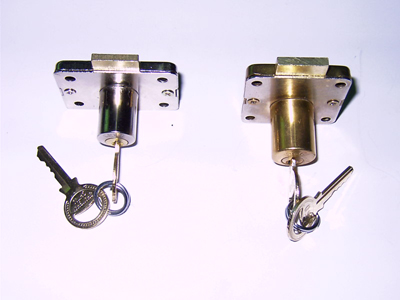 The lock industry today remains largely underdeveloped, with weak patent protection and little emphasis on innovation. Many hardware lock companies possess advanced patented technologies but struggle to prevent knock-offs from flooding the market. This results in a fragmented landscape where it’s difficult to distinguish quality products from inferior imitations.
Looking ahead, domestic hardware lock manufacturers need to shift their focus toward producing high-precision, multifunctional, and standardized products. This will require advancements in cutting-edge technologies like precision stamping, die casting, and surface treatments. Additionally, investing in automated assembly lines could help improve efficiency and reduce costs. As of now, most Chinese lock producers are small or medium-sized enterprises that face significant challenges due to redundant investments and outdated practices. To thrive, these companies must prioritize product quality, brand building, and technological upgrades.
China’s lock industry currently generates around 40 billion RMB annually, producing approximately 1.9 billion units. During the Eleventh Five-Year Plan period, the industry saw an impressive 31% average annual export growth rate, which far exceeded the broader hardware sector's average. In the first half of 2011 alone, lock exports reached $2.082 billion, representing a 15.9% increase year-over-year. Extrapolating this trend suggests an annual export value of roughly $4.6 billion. Imports also grew significantly, reaching $273 million in the same year, with projections suggesting they may rise to $550 million.
The growing demand for premium lock solutions both domestically and internationally has led to increased competition from global brands entering the Chinese market. While this presents immense opportunities, it also poses substantial challenges for local firms. One major obstacle is the disparity in processing capabilities compared to international standards. Most products remain middle-to-low grade mechanically, lacking the sophisticated engineering needed for higher-end applications. Furthermore, there’s a critical shortage of skilled personnel in areas such as research and management. This vulnerability underscores the importance of adopting innovative techniques and modernizing production methods to enhance resilience against external pressures.
Smart locks, particularly those incorporating biometric features like fingerprint scanners, have emerged as a promising segment within the lock industry. Their integration of electronic systems with physical mechanisms makes them appealing to tech-savvy consumers seeking convenience and security. Among foreign competitors, German brands stand out for their rigorous design philosophy and technical expertise. Companies like DESSMANN (China) have successfully localized German engineering principles while tailoring their offerings to suit Chinese preferences. Their fingerprint locks leverage unique biological identifiers, ensuring unparalleled reliability and ease of use. Such innovations not only address practical concerns but also elevate user experiences through intuitive interfaces and ergonomic designs.
In summary, the future of the lock industry lies in balancing tradition with progress. By embracing cutting-edge technologies and fostering collaboration between academia and industry, Chinese manufacturers can close existing gaps and carve out a stronger position globally. Moreover, prioritizing sustainability and ethical business practices will be crucial in establishing long-term credibility and trust among customers worldwide.
The lock industry today remains largely underdeveloped, with weak patent protection and little emphasis on innovation. Many hardware lock companies possess advanced patented technologies but struggle to prevent knock-offs from flooding the market. This results in a fragmented landscape where it’s difficult to distinguish quality products from inferior imitations.
Looking ahead, domestic hardware lock manufacturers need to shift their focus toward producing high-precision, multifunctional, and standardized products. This will require advancements in cutting-edge technologies like precision stamping, die casting, and surface treatments. Additionally, investing in automated assembly lines could help improve efficiency and reduce costs. As of now, most Chinese lock producers are small or medium-sized enterprises that face significant challenges due to redundant investments and outdated practices. To thrive, these companies must prioritize product quality, brand building, and technological upgrades.
China’s lock industry currently generates around 40 billion RMB annually, producing approximately 1.9 billion units. During the Eleventh Five-Year Plan period, the industry saw an impressive 31% average annual export growth rate, which far exceeded the broader hardware sector's average. In the first half of 2011 alone, lock exports reached $2.082 billion, representing a 15.9% increase year-over-year. Extrapolating this trend suggests an annual export value of roughly $4.6 billion. Imports also grew significantly, reaching $273 million in the same year, with projections suggesting they may rise to $550 million.
The growing demand for premium lock solutions both domestically and internationally has led to increased competition from global brands entering the Chinese market. While this presents immense opportunities, it also poses substantial challenges for local firms. One major obstacle is the disparity in processing capabilities compared to international standards. Most products remain middle-to-low grade mechanically, lacking the sophisticated engineering needed for higher-end applications. Furthermore, there’s a critical shortage of skilled personnel in areas such as research and management. This vulnerability underscores the importance of adopting innovative techniques and modernizing production methods to enhance resilience against external pressures.
Smart locks, particularly those incorporating biometric features like fingerprint scanners, have emerged as a promising segment within the lock industry. Their integration of electronic systems with physical mechanisms makes them appealing to tech-savvy consumers seeking convenience and security. Among foreign competitors, German brands stand out for their rigorous design philosophy and technical expertise. Companies like DESSMANN (China) have successfully localized German engineering principles while tailoring their offerings to suit Chinese preferences. Their fingerprint locks leverage unique biological identifiers, ensuring unparalleled reliability and ease of use. Such innovations not only address practical concerns but also elevate user experiences through intuitive interfaces and ergonomic designs.
In summary, the future of the lock industry lies in balancing tradition with progress. By embracing cutting-edge technologies and fostering collaboration between academia and industry, Chinese manufacturers can close existing gaps and carve out a stronger position globally. Moreover, prioritizing sustainability and ethical business practices will be crucial in establishing long-term credibility and trust among customers worldwide.
Friction Scratch Testing Instruments
Friction Scratch Testing Instruments,Scratch Testing Instruments,scratch hardness tester
Guangdong Yuwei Testing instrument Co., Ltd , http://www.yuweiinstrument.com